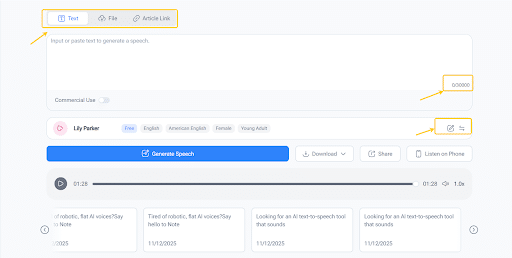Table of Contents
For creators who produce narrative content or podcasts, one of the biggest challenges is consistency. Recording long-form audio can be exhausting, time-consuming, and difficult to replicate across episodes. Vocal fatigue, inconsistent tone, and environmental noise are constant obstacles—even for experienced narrators.
NoteGPT Text to Speech offers a practical alternative that doesn’t feel artificial or robotic. Instead, it provides a workflow that allows creators to focus on storytelling, content planning, and creative decisions, while leaving repetitive narration tasks to the tool.
Why TTS Matters for Storytelling
Narrative content thrives on pacing, emotion, and clarity. Whether you’re producing a podcast episode, an audiobook, or a story-driven video series, a consistent, engaging voice is critical. Even small variations in tone can distract listeners or break immersion.
With NoteGPT, creators can generate a steady, natural-sounding narration that maintains tone across the entire piece. You can tweak speed, emphasis, and emotion to match the mood of each scene, which is especially useful for long stories or multiple episodes.
Managing Long Scripts Efficiently
One common problem in storytelling projects is handling scripts that stretch thousands of words. Traditional recording methods often require multiple sessions, editing, and stitching clips together. This not only consumes time but can also compromise the flow of the narrative.
NoteGPT allows creators to input long scripts—up to 30,000 characters at a time—via direct text, uploaded files, or even a webpage link. The tool generates natural-sounding audio in one go, preserving pacing and emotional tone throughout. For podcasters producing multiple episodes weekly, this efficiency is a game-changer.

Experimenting with Different Voices and Styles
In storytelling and podcast production, voice style and character differentiation are important. NoteGPT offers dozens of free voices across 100+ languages, allowing creators to experiment with narration style or even assign different voices to different characters or segments.
For example, a fictional story could feature a narrator in a calm tone while dialogue sections use slightly faster or more energetic voices. This makes faceless content feel dynamic and engaging without requiring multiple voice actors.
Voice Cloning for Personal Branding
For creators who want a personal touch, NoteGPT’s voice cloning feature is invaluable. By recording a few seconds of your own voice, you can generate a digital version that narrates scripts in your style. This ensures that your content maintains your unique brand identity even when you’re producing content rapidly or multitasking across projects.
Additionally, cloned voices can be applied across languages, making it easier to deliver translated versions of podcasts or stories without losing your recognizable vocal signature.
Solving Common Problems in Podcast Production
Daily production challenges for podcasters often include:
- Time constraints: Recording and editing episodes can take hours. With NoteGPT, audio can be generated instantly, freeing creators to focus on scripting, research, or editing.
- Vocal fatigue: Long episodes can strain your voice, impacting quality. TTS eliminates this risk while producing consistent results.
- Environmental issues: Background noise or poor acoustics can ruin recordings. NoteGPT works anywhere without requiring a studio.
- Revisions: When scripts change, updating audio is as simple as editing the text and regenerating, instead of re-recording entire segments.
These solutions reduce stress and make it possible to maintain a frequent publishing schedule without compromising audio quality.
Integrating TTS Into the Creative Workflow
Using NoteGPT in a storytelling or podcast workflow can look like this:
1. Draft the script or episode outline.
2. Input the script into NoteGPT via text, file, or link.
3. Select a voice or cloned version of your own voice.
4. Adjust speed, tone, and emotion to match your narrative needs.
5. Generate the audio and review for pacing and clarity.
6. Export and integrate into your video or podcast editing software.
This workflow allows for quick experimentation, easier revisions, and professional-quality narration, even for creators working solo.
Expanding Reach Through Multi-Language Narration
For podcasters or storytellers who want to reach international audiences, NoteGPT supports over 100 languages. This makes it possible to produce multiple language versions of the same content without hiring separate voice actors. You can maintain consistency, brand voice, and emotional tone across all versions, opening up global reach while saving time and cost.
Conclusion
Storytelling and podcast production demand consistency, clarity, and emotional engagement. NoteGPT Text to Speech provides creators with a reliable solution for these challenges, offering natural-sounding voices, voice cloning, multi-language support, and flexible control over pacing and tone.
For anyone producing long-form content, serial podcasts, or narrative-driven videos, NoteGPT reduces repetitive work, eliminates vocal strain, and allows you to focus on what truly matters: telling compelling stories. By integrating TTS into your workflow, you can produce more content, maintain quality, and even reach audiences in multiple languages—all without recording a single additional hour in a studio.
